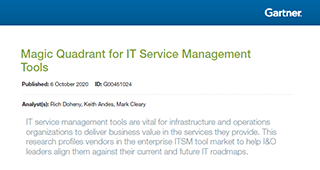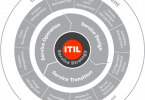Although it sounds obvious, Information Technology Service Management (ITSM) success lies in how you position your ITSM efforts in relationship to your enterprise. Two key questions to consider with ITSM are: 1) What are the driving forces behind your ITSM efforts? and 2) Does your ITSM implementation serve as a comprehensive enterprise strategy or is it an ad-hoc implementation?
These questions are important regarding what you do with your ITSM environment (your benefits) and why you do it (your business drivers). At least that’s what a recent 2017 Forbes Insights survey on The State of Information Technology Service Management (ITSM) tells us about the experiences of enterprise strategy ITSM organizations versus ad-hoc ITSM organizations.
ITSM progression: Enterprise strategy organizations versus ad-hoc strategy organizations
Forbes Insights survey respondents were asked to “rate the degree to which your ITSM strategy is positioned as a comprehensive enterprise strategy, versus a more ad-hoc or piecemeal approach.” The results showed a maturing ITSM landscape where the following occurred at the top and bottom end of the respondent’s self-ratings.
At the top, 24% of the surveyed organizations ranked their ITSM efforts in the highest level category of being a competitive enterprise strategy. Service management delivery generally has three significant characteristics in these organizations:
- Service management is deployed across their entire enterprise, not just IT
- Service management is built into the organization’s competitive strategy going forward
- Service management is deployed well beyond the boundaries of their IT departments, to both their internal and their external customers
We’ll call these organizations enterprise strategy organizations or more advanced ITSM organizations.
At the bottom end of the ranking, 10% of the surveyed organizations ranked their ITSM efforts at the lowest levels, meaning they considered their ITSM efforts to still be rudimentary.
We’ll call these organizations ad-hoc strategy organizations or less advanced ITSM organizations.
A significant part of the Forbes Insights survey focuses on the experiences of these opposite groups, in terms of their ITSM progression. Many of these contrasts play out in the business drivers motivating enterprise strategy and ad-hoc strategy organizations, and in the benefits these organizations receive from ITSM.
Why implement ITSM?
According to the survey, there is a noticeable difference in the number of business drivers each type of organization can satisfy. Restated from Figure 22 in the Forbes Insights survey, here are the most important business drivers listed for less advanced ITSM organizations (by percentage reported for each business driver) versus the percentages that more advanced ITSM organizations reported.
| Percentage organizations reporting each business driver | |||
|---|---|---|---|
| ITSM Business Driver (reason for using ITSM) | Less Advanced ITSM organizations | More Advanced ITSM organizations | Difference between organizational types |
| Increasing employee productivity | 24% | 40% | -16% |
| Cost reduction | 20% | 17% | +3% |
| Minimizing risk | 20% | 13% | +7% |
| Move to a digital enterprise | 16% | 21% | -7% |
| Enabling compliance | 12% | 14% | -2% |
| Improving operational efficiency | 8% | 60% | -52% |
| Enabling transformational agility | 8% | 6% | -2% |
| Driving employee engagement/productivity | 4% | 2% | -2% |
| Improving customer experience | 0% | 8% | -8% |
The most interesting thing is that there are only two business drivers (cost reduction and minimizing risk) that less advanced ITSM organizations reported more often than more advanced ITSM organizations. Conversely, the other seven business drivers were reported more often for more advanced ITSM organizations versus less advanced ITSM organizations. And two of the business drivers were reported at a significantly higher rate for more advanced organizations (i.e., increasing operational efficiency at a 52% difference and increasing employee productivity at a 16% difference).
The lesson we can draw here is that less advanced ITSM organizations are mostly concerned with the starter business drivers of ITSM (employee productivity, cost reduction, minimizing risk, moving to a digital enterprise, etc.) and in fewer business drivers overall. More advanced organizations are also concerned with these items, but in much higher numbers. In short, the longer an organization runs an ITSM environment and the more centered ITSM implementation is around the entire enterprise and its competitive strategy, the more business drivers it can satisfy within that environment.
Who benefits?
There’s a similar difference when you look at the ITSM benefits incurred between less advanced and more advanced ITSM organizations. Restated from Figure 24 of the Forbes Insight survey, here are the top ITSM benefits experienced for less advanced ITSM organizations versus more advanced organizations.
| Percentage organizations experiencing each benefit | |||
|---|---|---|---|
| ITSM Benefit | Less Advanced ITSM organizations | More Advanced ITSM organizations | Differential |
| Cost savings in IT systems | 28% | 49% | -21% |
| Cost savings in business processes | 28% | 40% | -12% |
| Increased employee productivity | 16% | 48% | -32% |
| Faster time to market for product/services | 16% | 14% | +2% |
| Faster response to customers | 12% | 25% | -13% |
| Better support for digital opportunities | 8% | 3% | +5% |
Here the differences are more stark. In four out of six benefit categories, more advanced ITSM organizations are experiencing benefits at a greater level than less advanced ITSM organizations. And most of the differences are in double digits.
The finding here is clear. More advanced ITSM companies experience more benefits than less advanced organizations.
Focus your ITSM around your entire organization and stay with it
At the risk of being redundant, these survey findings show ITSM success lies in how you position your ITSM efforts in relationship to your entire enterprise. Organizations that position ITSM across the entire enterprise (not just IT), and build it into their competitive strategy, are likely to satisfy more business needs and experience more benefits than organizations that build their ITSM strategy in an ad-hoc or piecemeal manner. These finding also show the time value of ITSM in satisfying business needs and experiencing benefits. The longer you work and refine an ITSM environment, the more you’ll get out of it. As I said, it seems obvious but the survey gives us concrete validation of these facts.
About the Forbes Insight survey
The 2017 Forbes Insight survey focused on the state of information technology service management (ITSM). It surveyed 261 senior-level executives from around the world, representing organizations at various revenue levels from small (<$500 million) to large (> $5 billion), and its survey results can serve as a proxy for the state of IT and ITSM worldwide.






